Timeline of women's colleges in the United States
The following is a timeline of women's colleges in the United States. These are institutions of higher education in the United States whose student populations are comprised exclusively or almost exclusively of women. They are often liberal arts colleges. There are approximately sixty active women's colleges in the U.S.
Colleges are listed chronologically by the date in which they opened their doors to students.
First and oldest
- Main article: Timeline of historically black women's colleges
Many of the schools began as either schools for girls, academies (which during the late 18th and early 19th centuries was the equivalent of secondary schools), or as teaching seminaries (which during the early 19th century were forms of secular higher education), rather than as a chartered college. During the 19th century in the United States, "Seminaries educated women for the only socially acceptable occupation: teaching. Only unmarried women could be teachers. Many early women's colleges began as female seminaries and were responsible for producing an important corps of educators." [1]
The following is a list of "oldest" and "first" schools:
- 1742: Bethlehem Female Seminary, (now Moravian College): established as a seminary for girls, it eventually became the Moravian Seminary and College for Women and later merged with nearby schools to become the coeducational school, Moravian College.
- 1772: Little Girls' School, (now Salem College): Originally established as a primary school, it later became an academy (high school) and finally a college. It is the oldest female educational establishment that is still a women's college, and the oldest female institution in the Southern United States.
- 1818: Elizabeth Female Academy: first female educational institution in Mississippi; it closed in 1843
- 1833: Columbia Female Academy (now Stephens College): Originally established as an academy (high school), it later became a college. It is the second oldest female educational establishment that is still a women's college.
- 1837: Mount Holyoke Female Seminary (now Mount Holyoke College): It is the oldest (and first) of the Seven Sisters. It is also the oldest school which was established from inception (chartered in 1836) as an institution of higher education for women (teaching seminary) that is still a women's college.*1838 Judson College, formerly Judson Female Institute. Founded by Milo Jewett who later founded Vasser.
- 1839: Georgia Female College (now Wesleyan College): It is the oldest (and the first) school which was established from inception (chartered in 1836) as a college for women.
- 1848: Philadelphia School of Design for Women (now Moore College of Art and Design): It is the first and only art school which is a women's college.
- 1851: Cherokee Female Seminary: It is the first institute of higher learning exclusively for women the United States west of the Mississippi River. Along with the Cherokee Male Seminary, this was the first college created by a tribe instead of the US federal government.
- 1851: Tennessee and Alabama Female Institute (later Mary Sharp College): It was the first women's college to grant college degrees to women that were the equivalent of those given to men; the college closed due to financial hardship in 1896.
- 1852: Young Ladies Seminary (now Mills College): It is the first women's college in United States west of the Rocky Mountains
- 1855: Elmira Female College (now Elmira College): It is the oldest college still in existence which (as a women's college) granted degrees to women that were the equivalent of those given to men; the college became coeducational in 1969.
- 1861: Vassar College: It is the first of the Seven Sisters which was established from inception as a college for women; it became coeducational in 1969.
- 1867: Scotia Seminary (now Barber-Scotia College): It was the first historically black female institution of higher education established after the American Civil War and became a women's college in 1946. It became a coeducational school in 1954 and lost its accreditation in 2004.
- 1881: Atlanta Baptist Female Seminary (now Spelman College): It was the first historically black female institution of higher education to receive its collegiate charter in 1924, making it the oldest historically black women's college.
- 1884: Industrial Institute & College, (now Mississippi University for Women): It was the first public women's college; became coeducational in 1982 as a result of the Supreme Court's Mississippi University for Women v. Hogan case, but maintained its original name.
Timeline
Colonial–era schools

- 1742: Bethlehem Female Seminary: Founded in Germantown and later moved to Bethlehem, Pennsylvania. It received its collegiate charter in 1863 and in 1913, it became the Moravian Seminary and College for Women. In 1954, it merged with the male institution Moravian College and Theological Seminary and became the coeducational school, Moravian College [2]
- 1772: Little Girls' School (now Salem College): Originally established as a primary school, it later became an academy (high school) and finally a college. It is the oldest female educational establishment that is still a women's college, and the oldest female institution in the Southern United States.
1780s–1820s
- 1787: Young Ladies' Academy of Philadelphia [1]
- 1792: Litchfield Female Academy: Founded in Litchfield, Connecticut; it closed in 1833.
- 1814: Louisburg Female Academy (now Louisburg College): Founded in North Carolina; Louisburg Female College, founded in 1857. Later merged with Franklin Male Academy
- 1814: Troy Female Seminary: It became the Emma Willard School in 1895
- 1818: Elizabeth Female Academy: First female educational institution in Mississippi; it closed in 1843
- 1821: Clinton Female Seminary: Georgia. Forerunner to Wesleyan College [2]
- 1823: Hartford Female Seminary: It closed towards the later half of the 19th century
- 1828: Ipswich Female Seminary: It closed in 1878
1830s
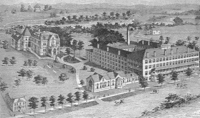
- 1831: LaGrange Female Academy (now LaGrange College): Founded in LaGrange, Georgia, it became LaGrange Female College in 1851, and coeducational in 1953
- 1833: Columbia Female Academy (now Stephens College): Originally established as an academy (high school), it later became a college. It is the second oldest female educational establishment that is still a women's college
- 1834: Wheaton Female Seminary (now Wheaton College, Massachusetts): Founded with the help of Mary Lyon; Wheaton became a college in 1912 and coeducational in 1987
- 1835: Livingston Female Academy and State Normal College (now University of West Alabama); It became coeducational in the 1950s
- 1836: Washington Female Seminary: closed in 1948
- 1836: Wesleyan College: Chartered as the Georgia Female College on December 23, 1836, Wesleyan is the world's oldest women's college. Still a women's college
- 1837: Mount Holyoke Female Seminary (now Mount Holyoke College): It is the oldest (and first) of the Seven Sisters
- 1838: Judson Female Institute (Judson College (Alabama)): Founded in Marion, Alabama, it became Judson College in 1903 and later Judson College
- 1839: Farmville Female Seminary Association (now Longwood University): Founded in Farmville, Virginia; it became coeducational in 1976.

- 1840: Saint Mary-of-the-Woods College
- 1841: Academy of the Sacred Heart (now Manhattanville College)
- 1842: Fulton Female Academy (now Synodical College): Founded in Fulton, Missouri, it closed in 1928
- 1842:Valley Union Seminary (now Hollins University): Established in Roanoke, Virginia as a coeducational school, it became a school for women in 1852, and was renamed Hollins Institute in 1855, Hollins College in 1911, and Hollins University in 1998
- 1842: Augusta Female Seminary (now Mary Baldwin College): Founded in Staunton, Virginia, it became the Mary Baldwin Seminary in 1895, and the Mary Baldwin College in 1923
- 1844: Saint Mary's College (Indiana): Founded by the Sisters of the Holy Cross
- 1845: Limestone Springs Female High School: (now Limestone College) Founded in Gaffney, South Carolina, it began accepting a few male students in the 1920s (who did not live on campus) and became fully coeducational in the late 1960s
- 1846: Greensboro Female College: Charted in 1838 in Greensboro, North Carolina; it is now the coeducational school Greensboro College
- 1846: Illinois Conference Female Academy: It is now the coeducational school, MacMurray College
- 1847: Kentucky Female Orphan School (now Midway College)
- 1847: Academy of Mount Saint Vincent: (now College of Mount Saint Vincent). Founded by the Sisters of Charity of New York; moved from Manhattan to current Riverdale, Bronx site in the 1850's and began service as degree-granting, four-year liberal arts college in 1911. Became coeducational in 1974.
- 1848: Philadelphia School of Design for Women (now Moore College of Art and Design): It is the first and only art school which is a women's college
- 1848: Chowan Baptist Female Institute; it is now the coeducational school Chowan University
- 1848: Drexel University College of Medicine: It is now, after several changes including becoming co-ed, Drexel University's College of Medicine

- 1849: The Oread Institute: It closed in 1881.
- 1849: Forsyth Female Collegiate Institute: It is now coeducational Tift College
1850s
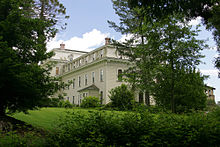
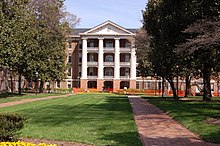
- 1851: Christian College (later Columbia College): It was the first women's college west of the Mississippi River to be chartered by a state legislature. [3]
- 1851: Cherokee Female Seminary: It is the first institute of higher learning exclusively for women the United States west of the Mississippi River. Along with the Cherokee Male Seminary, this was the first college created by a tribe instead of the US federal government.
- 1851: Tennessee and Alabama Female Institute (later Mary Sharp College): It was the first women's college to grant college degrees to women that were the equivalent of those given to men; the college closed due to financial hardship in 1896
- 1852: Young Ladies Seminary (now Mills College): It is the first women's college in United States west of the Rocky Mountains
- 1853: Beaver College: It became the coeducational school Arcadia University
- 1853: Ohio Wesleyan Female College: It merged with Ohio Wesleyan University in 1877
- 1854: Columbia College (Columbia, South Carolina)
- 1854: Andrew Female College (now Andrew College): Became coeducational in 1956
- 1855: Elmira Female College (now Elmira College): It is the oldest college still in existence which (as a women's college) granted degrees to women that were the equivalent of those given to men; the college became coeducational in 1969.
- 1855: Western Female Seminary: Became Western College for Women and later merged with merged with Miami University in 1974.
- 1857: Peace Institute (now Peace College): Founded in Raleigh, North Carolina
- 1857: Charlotte Female Institute: founded in Charlotte, North Carolina; became the coeducational Queens University of Charlotte in 1987 after World War II
1860s
- 1861: Vassar College: It is the first of the Seven Sisters which was established from inception as a college for women; it became coeducational in 1969.
- 1864: Visitation Academy: It later became Ottumwa Heights College and closed in 1980
- 1866: Baylor Female College (originally the Female Department of Baylor University, founded in 1845): Became the coeducational school University of Mary Hardin-Baylor in 1971.
- 1867: Cedar Crest College
- 1867: Scotia Seminary (now Barber-Scotia College): It was the first historically black female institution of higher education established after the American Civil War and became a women's college in 1946. It became a coeducational school in 1954 and lost its accreditation in 2004. (historically black college)
- 1868: Wells College: It became coeducational in 2005
- 1869: Pennsylvania Female College: It became Chatham College in 1955 and Chatham University in 2007. Although the University is coeducational, the undergraduate college, Chatham College for Women, remains women-only. The undergraduate college at its founding granted degrees to women that were the equivalent of those given to men.
- 1869: Wilson College
- 1869: Hamilton College (Kentucky): It closed in 1932
1870s
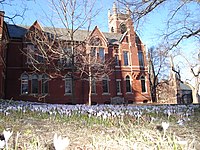
- 1870: Hunter College: became coeducational in the 1950s
- 1871: Ursuline College
- 1872: St. Mary's Institute: Became Mount Mary College in 1929
- 1873: Bennett College: Founded in Greensboro, North Carolina as a coeducational school, it became a women's college in 1926
- 1873: College of Notre Dame of Maryland
- 1873: Blue Mountain Female Institute: Now Blue Mountain College
- 1873: Cherokee Baptist Female College: Became the coeducational school Shorter College during the 1950s
- 1875: Wellesley College: Originally charted in 1870 (Seven Sisters)
- 1875: Smith College: Originally chartered in 1871 (Seven Sisters)
- 1875: Mount Hermon Female Seminary: Founded in Clinton, Mississippi, it closed in 1924 (historically black college)
- 1875: Mount Vernon College for Women: Merged with George Washington University in 1999
- 1878:Georgia Baptist Female Seminary (now Brenau University): Founded in Gainesville, Georgia, it became Brenau College in 1900, and Brenau University in 1992
- 1879: Harvard Annex: It was chartered as Radcliffe College by the Commonwealth of Massachusetts in 1894;Radcliffe closed in 1999 when its merger with Harvard University was complete (Seven Sisters)
1880s

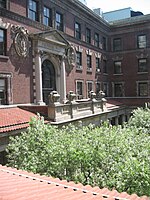

- 1881: Tillotson College: Founded as a coeducational, it was a women's college from 1926-1935. It is now the coeducational school, Huston-Tillotson University (historically black college)
- 1881: Atlanta Baptist Female Seminary (now Spelman College): It was the first historically black female institution of higher education to receive its collegiate charter in 1924, making it the oldest historically black women's college
- 1883: Seton Hill University: It became coeducational in 2002
- 1883: Hartshorn Memorial College founded in Richmond, Virginia. In 1932, it merged with Virginia Union University.[4][5]
- 1884: Industrial Institute & College, (now Mississippi University for Women): It was the first public women's college; became coeducational in 1982 as a result of the Supreme Court's Mississippi University for Women v. Hogan case, but maintained its original name
- 1884: Cottey College is founded as "Vernon Seminary," a day and boarding school for girls.
- 1885: Bryn Mawr College (Seven Sisters)
- 1885: The Women's College of Baltimore: Became Goucher College in 1910 and coeducational during the 1980s
- 1886: H. Sophie Newcomb Memorial College: Closed in 2006
- 1886: Mary Allen Seminary : Founded in Crockett, Houston County, Texas. It became coeducational in 1933. [6]
- 1887: Evelyn College for Women: It was the coordinate women's college of Princeton University in Princeton, New Jersey; it closed in 1897
- 1887: Alverno College
- 1889: Converse College
- 1889: Decatur Female Seminary (now Agnes Scott College): Founded in Decatur, Georgia, it became the Agnes Scott Institute in 1890, and Agnes Scott College in 1906
- 1889: Barnard College (Seven Sisters)
- 1889: Georgia College & State University: The coordinate college (Georgia Normal & Industrial College) for Georgia Tech; it became coeducational in 1967
1890s
- 1890: Mount Saint Agnes College: It closed in 1972
- 1891: Pembroke College: Was the coordinate women's college for Brown University in Providence, Rhode Island; It merged with Brown in 1971
- 1891: Randolph-Macon Woman's College: It become coeducational and changed its name to Randolph College in 2007
- 1891: North Carolina Women's College: It became the coeducational school University of North Carolina at Greensboro in 1963
- 1891:Baptist Female University, (now Meredith College): Founded in Raleigh, North Carolina, it became the Baptist University for Women, in 1891, and Meredith College in 1909
- Hood College: Became coeducational in 2002
- 1896: Barber Memorial College: Founded in Anniston, Alabama, it merged with Scotia Women's College (formerly Scotia Seminary) in Concord, North Carolina in 1930 to become Barber-Scotia Junior College (historically black college)
- 1897: Trinity College: Trinity Washington University since 2004
- 1897: Bay Path College
- 1899: Simmons College (Massachusetts)
- 1899: College of Saint Elizabeth
1900s
- 1901: Sweet Briar College
- 1901: Texas State College for Women founded, as Girls Industrial College. Known as Texas Woman's University since 1957. Technically co-ed since 1994, but still has a primarily female student body.
- 1901: St. Clara's College: Became coeducational in 1970 and Dominican University (Illinois) in 1997
- 1903: Margaret Morrison Carnegie College: It was the coordinate women's college of Carnegie Mellon University between 1903 and 1973
- 1903: Young Woman's Industrial Club: It became Skidmore College in 1922 and coeducational in 1971
- 1904: The College of New Rochelle
- 1905: College of St. Catherine
- 1907: College of Saint Teresa: It closed in 1989.
- 1908: Georgian Court University
- 1908: William Smith College is founded: Eventually becomes a coordinate college known as Hobart and William Smith
- 1908 James Madison University: It became coeducational in 1966
- 1908: University of Mary Washington: Developed as a coeducational school, it became the coordinate women's college of The University of Virginia from 1944 to 1970; It returned to coeducation in 1970.
- 1909: Lesley College: It became coeducational in 2005
1910s
- 1911: Pine Manor College
- 1911: Connecticut College: It became coeducational in 1969
- 1913: College of Saint Benedict: Has been partnered with the all-male Saint John's University, about 3.5 miles (6 km) away, from its inception. The two schools share a common academic program, and students have full access to the resources of both campuses. However, the institutions remain legally and administratively separate.
- 1916: Russell Sage College
- 1918: New Jersey College for Women: Founded as the coordinate college for Rutgers University and became Douglass College in 1955; it closed in 2007 and became a residential college for Rutgers University
- 1919: Emmanuel College, Boston: It became coeducational in 2001
1920s


- 1920: Immaculata University: It became coeducational in 2005
- 1921: Rosemont College
- 1923: College of Saint Mary
- 1923: Marymount Junior College: Became Marymount College of Los Angeles in 1948 when it began offering bachelor's degrees. Merged with Loyola University of Los Angeles, then all-male at the undergraduate level, in 1973 to create Loyola Marymount University.
- 1923: Mount St. Scholastica College: Merged with the all-male St. Benedict's College in 1971 to form the co-educational Benedictine College
- 1924: Chestnut Hill College: It became coeducational in 2003
- 1925: Mount St. Mary's College
- 1925: Albertus Magnus College: It became coeducational in 1985
- 1926: Sarah Lawrence College: It became coeducational in 1968
- 1926: Scripps College
- 1927: Regis College: It become coeducational in 2007
1930s–1980s
- 1932: Bennington College: It became coeducational in 1969
- 1932: Saint Joseph College (Connecticut)
- 1936: Marymount Manhattan College: It is currently coeducational
- 1941: Annhurst College: It closed in 1980
- 1941: Mercy College of Detroit: Opened as a women's college, later became coeducational, and merged with the University of Detroit in 1990, creating the University of Detroit Mercy.
- 1946: Mount Sacred Heart College: It closed in 1997
- 1947: Garland Junior College: It was absorbed into Simmons College in 1976.
- 1954: Stern College for Women
- 1963: Pitzer College: It became coeducational in 1970
- 1982: Women's College of the University of Denver
See also
- Seven Sisters (colleges)
- List of current and historical women's universities and colleges in the United States
- Women's colleges in the United States
- Women's colleges in the Southern United States
- Women's College Coalition
Further reading
- Creighton, Joanne V. A Tradition of Their Own: Or, If a Woman Can Now Be President of Harvard, Why Do We Still Need Women’s Colleges?.
- Guy-Sheftall, Beverly. "Black Women and Higher Education: Spelman and Bennett Colleges Revisited." The Journal of Negro Education, Vol. 51, No. 3, The Impact of Black Women in Education: An Historical Overview (Summer, 1982), pp. 278-287.
- Kiss, Elizabeth. "Reaffirming Our Commitment to Women's Education". Agnes Scott College. Retrieved 2006-10-20.
- Harwarth, Irene B. "A Closer Look at Women's Colleges." National Institute on Postsecondary Education, Libraries, and Lifelong Learning, Office of Educational Research and Improvement, U.S. Department of Education, 1999.
- ---, Mindi Maline and Elizabeth DeBra. "Women's Colleges in the United States: History, Issues, and Challenges: Executive Summary." U.S. Department of Education National Institute on Postsecondary Education, Libraries, and Lifelong Learning.
- Indiana University Center for Postsecondary Research (IUCPR). "New study finds women’s colleges are better equipped to help their students."
- Horowitz, Helen Lefkowitz. Alma Mater: Design and Experience in the Women's Colleges from Their Nineteenth-Century Beginnings to the 1930s, Amherst: University of Massachusetts Press, 1993 (2nd edition).
- Muhlenfeld, Elisabeth and Nancy Gray. "Women's colleges must be an option." The Roanoke Times, September 14, 2006.
- Rosenberg, Rosalind. "The Limits of Access: The History Of Coeducation in America." In Women and Higher Education: Essays from the Mount Holyoke College Sesquicentennial Symposia. Ed. John Mack Faragher and Florence Howe. New York: Norton, 1988.
- Scrimshaw, Susan (2006-10-04). "Yes to women's colleges". The Boston Globe. Retrieved 2006-10-14.
{{cite news}}: Italic or bold markup not allowed in:|publisher=(help) - Simpson, April (2006-11-05). "'Sisters' don't want a future in coeducation: Women's colleges see an obligation". The Boston Globe. Retrieved 2006-11-06.
{{cite news}}: Italic or bold markup not allowed in:|publisher=(help) - Whitson, Caroline (2006-10-17). "The case for women's colleges". Columbia College. Retrieved 2006-10-20.
